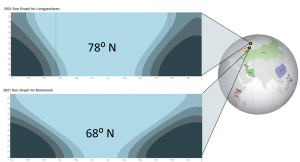Time: Arctic
Contents
Overview
The Arctic is a unique temporal region because of the combined effects of international conventions on times and dates as well as the axial tilt of the Earth itself. In most places on Earth, local time is determined by longitude, such that the time of day is more-or-less synchronized to the position of the sun in the sky (for example, at midday the sun is roughly at its highest). Time zones become less meaningful closer to the geographic North Pole, where all lines of longitude converge.
By convention, Greenwich Mean Time (GMT +0) (ZULU) is used at the pole itself, although some polar expeditions use whichever time zone is convenient, such as the time zone of the country from which they departed. Donovia?s Arctic regions span seven time zones; Greenland and Canada?s Arctic regions each span four. Arctic daylight hours are also exaggerated compared to lower latitudes. The vast majority of the Arctic population is concentrated in time zones GMT +1 (ALFA), GMT +2 (BRAVO), and GMT+3 (CHARLIE).
Key Dates, Time Periods, Events
| Twilight Only
25 SEP ? O6 OCT |
Night
07 OCT ? 04 MAR |
Twilight Only
05 MAR ? 17 MAR |
Daylight
18 MAR ? 24 SEP |
| Twilight Only 27 OCT ? 12 NOV | Night
14 NOV ? 14 FEB |
Twilight Only 15 FEB ? 17 APR | Daylight
18 APR ? 22 AUG |
| 12 hours, 18 minutes
22 SEP |
2 hours, 11 minutes
22 DEC |
12 hours, 18 minutes
20 MAR |
Daylight
06 JUN ? 05 JUL |
Cultural Perception of Time (Cross-Border Indigenous Groups)
Although there are dozens of indigenous circumpolar peoples, they account for less than ten percent of the Arctic population. Two major cross--specific sections.
=== -cycles and prevailing weather conditions.
| Season | Condition | Season | Condition |
|---|---|---|---|
| Spring-Winter
|
Pre-Autumn
| ||
| Spring
|
Autumn
| ||
| Pre-Summer
|
Pre-Winter
| ||
| Summer
|
Much of this season is bathed in twenty- | Winter
|
Under a cover of twenty- |
Inuit
| Season | Condition | Season | Condition |
|---|---|---|---|
| Ukiuq | Mid-January to Mid-March, Daylight returns but it remains cold, land is snow covered and sea ice is present | Aujuq | Mid-July to Mid-September, Long daylight periods, Warmest time of the year, seas are open |
| Upingaksaaq | Mid-March to Mid-May, Long daylight periods but cold, land is snow-covered and sea ice is present | Ukiaqsaaq | Mid-September to Mid-November, Increasing periods of darkness, Snow covers land but seas are open |
| Upingaaq | Mid-May to Mid-July, Longest daylight periods, Land is snow free but sea ice is present | Ukiaq | Mid-November to Mid-January, Dark during daytime, sea ice is present |
Tactical Perception of Time
The Arctic will always remain a unique temporal region and its impacts will always affect forces operating in high latitudes. The Arctic crosses all time zones and multiple geographic combatant commands, operational forces cannot expect to have ideal contemporaneous battle rhythm with parent commands. During summer, long periods of daylight will remove cover of darkness as a tool in planning operations. During winter, persistent night will require more widespread use of night vision technology.
Integrated planning and coordination with indigenous partner forces and local civil authorities may be challenging because of perceptions of expectations and communication of time.

